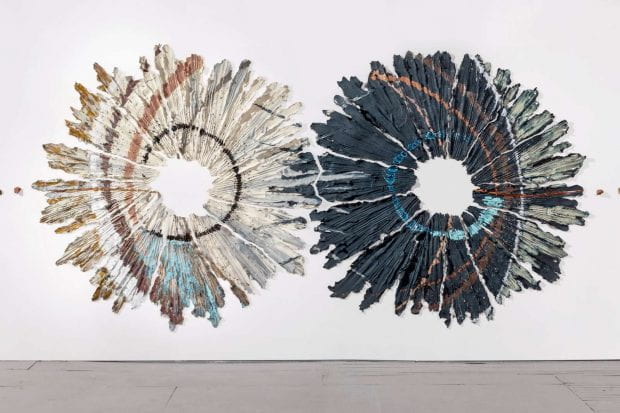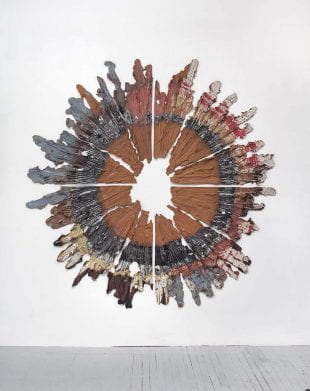Brie Ruais is one of the foremost young sculptors working in clay today, and Rice’s Moody Center for the Arts will host her first institutional solo exhibition this summer when “Brie Ruais: Movement at the Edge of the Land” opens June 5.
Ruais’ large-scale ceramic works, often rendered in tones of earth and water, challenge the static nature of sculpture. By highlighting the physical and psychological connections between the human body and the earth, they invite viewers to reflect on our evolving relationship to the natural world.
“Brie Ruais has a unique ability to create powerful ceramic sculptures that, despite their size and weight, seem almost delicate,” said Moody associate curator Frauke V. Josenhans. “They symbolize the force and solidity of nature, but also reflect the fragility of our global environment.”
Josenhans said Ruais approaches each work not only as sculpture, but also as performance, with the impressions of her palms, knuckles and feet visible in the clay.
“She wrestles as well as embraces the medium, a metaphor for the earth,” Josenhans said. “The unique and multifaceted aesthetic of her large-scale sculptures invigorates the medium of ceramic, and inscribes it in a fully contemporary approach, while connecting to larger topics.”
Fittingly, “Movement at the Edge of the Land,” on view through Aug. 28, will be activated by a series of movement-based performances and public events over the course of the exhibition.
During the June 5 opening reception, choreographer and Houston Ballet first soloist Oliver Halkowich will preview a new work across both galleries and outdoors, featuring two dancers and a musician. June 12, the Moody’s Dimensions Variable program will present Halkowich’s full performance, as well as a hands-on ceramic workshop in collaboration with ClayHouston.
Addressing urgent questions resulting from human consumption and the scarcity of natural resources in the Anthropocene, Ruais’ work stresses our collective dependence on ecological preservation and the fragility of our ecosystem. Her sculptures point to the effect industrialized civilizations have had on landscapes, and the disregard for environmental, human and spiritual concerns.
“My practice relies on the understanding that the land and the human body share similar vulnerabilities and ways of being affected, marked and colonized,” said Ruais, who creates each piece using the equivalent of her body’s weight in clay, which she engages with a physically intensive performance.
“The clay is pushed and spread out on the floor, rammed and compressed against a wall, torn and desiccated,” Ruais said. “I see the sculptures as bodies imprinted with the forces that have shaped them.”
“Movement at the Edge of the Land” will feature monumental ceramic sculptures created specifically for the Moody’s exhibition and mounted for the first time. Arranged on the floor and walls, the works will interact with both the galleries and the Rice campus, referencing the transformation of the American landscape in the wake of human development.
“Withdrawing Body, Emerging Earth,” a large-scale floor installation that extends from the interior of the gallery to the outdoor grounds, combines ceramic sculptures, construction debris and raw materials like dirt and rock. Ruais presents the extracted materials of the built environment and reorients us to our surroundings through a bodily lens.
A new video installation, “Tidal Movement,” presented in the Brown Foundation Gallery, poses timely concerns regarding the reorientation of human movement through the world, as we attempt to reconnect with nature and its cycles. The artist’s practice reflects the psychological and emotional resonances of the varying environments she inhabits: New York City, at the edge of an urban sea, and the deserts of the American West.
In collaboration with the Moody, the Barbara and David Gibbs Recreation Center will also organize a series of mindful movement and strength-building classes in the exhibition. Open to the Rice Community, these classes will allow participants to connect with the artworks on view through the practices of tai chi, walking meditation and restorative yoga.
An opening reception June 5 from 6-8 p.m. will feature a brief introduction by the artist. The reception is free and open to the public, and reservations are required.
“Brie Ruais: Movement at the Edge of the Land,” June 5-Aug. 28, Moody Center for the Arts. Free. For more information, visit moody.rice.edu.


